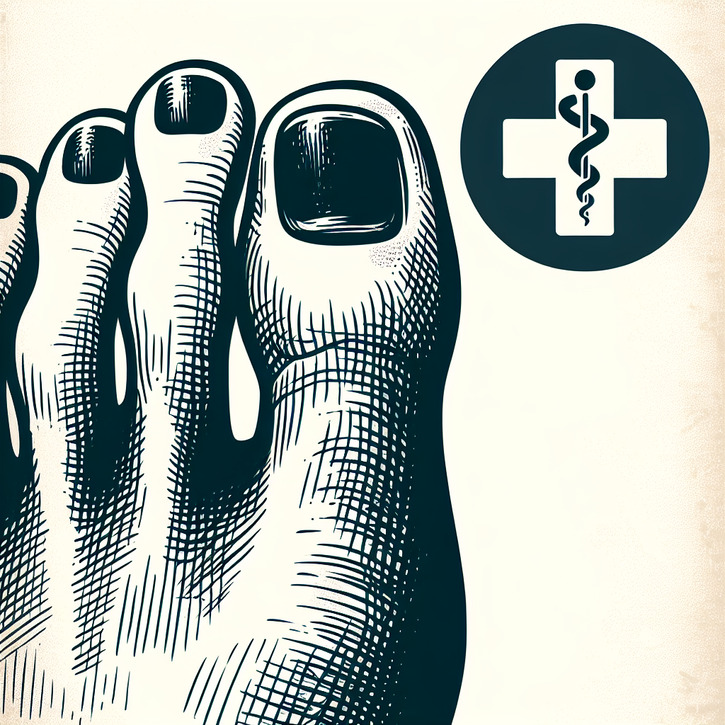Why Is My Toenail Turning Black? Understanding the Possible Reasons

Introducing Black Toenail Worries
What Exactly Is a Black Toenail? Let’s Break It Down
Ever notice your toenail isn’t looking its usual peachy pink and instead has taken on a dark, almost black look? It might seem like just a cosmetic quirk, but sometimes it’s a sign that something more’s going on beneath the surface. Essentially, a black toenail happens when your nail's natural color shifts—often because of blood pooling under it, a pesky fungal infection, or even other underlying issues. Sure, it could just be from a little bump or stubbed toe, but sometimes it signals a problem that deserves a closer look. Think of your nails as little windows into your overall health, giving you clues to potential issues lurking inside. Today, we’re diving into the many reasons behind these darkened toenails, balancing the cosmetic side with the real-deal health info you need.
Catching the Early Clues of a Black Toenail
At first, you might see just a small speck or streak of darkness, which can slowly grow more noticeable. Over time, that tiny spot can morph into a full-blown black spot on your nail. Along with the color change, you might feel some tenderness around the nail, notice a bit of swelling, or even feel a twinge of pain when you press on it. Sometimes the nail might even seem thicker or have a strange texture along with the discoloration. Spotting these early signs can really help you nip any potential issues in the bud—it's a signal to either take a closer look at your nail or get a professional opinion, especially if things seem to be getting worse.
Why the Change in Your Toenail Color Is Important
Believe it or not, a change in your toenail’s color might mean more than just an off-putting look. A blackened toenail can be a red flag, hinting at accidental injuries, pesky fungal infections, or even some more serious systemic health issues. It’s a subtle way your body is trying to tell you something’s up. Recognizing that your nail might be more than just a cosmetic concern is a key step in staying on top of your health. With a timely response, many complications can be prevented, making it crucial to treat these changes with the attention they deserve.
Diving Into the Medical Causes of a Black Toenail
When Impact and Injury Turn Your Nail Black
One of the top reasons behind a black toenail is plain old trauma. If you’ve stubbed your toe or been involved in any kind of blunt force to your foot—maybe during sports or even everyday mishaps—that could cause tiny blood vessels beneath your nail to burst. This condition, known as a subungual hematoma, makes the nail look dark as the blood accumulates underneath. While your body will naturally work on healing the damage, depending on how bad it is, you might be dealing with discomfort and altered nail color for weeks at a time. If you suspect that a bump or bruise is the culprit, keeping an eye out for signs of infection and giving your toe some well-deserved rest go a long way.
How Fungal Infections Can Darken Your Toenail
Another player in the field of discolored toenails is fungus. These infections don’t just alter the color—they can also make your nail thicken, crumble, or develop a gritty texture. Since fungus loves moist, warm areas, people who sweat excessively or wear tight shoes are often more at risk. The earliest hints might be a slight discoloration or a minute change in texture. Usually, antifungal creams, ointments, or even oral medications paired with good foot hygiene can clear things up. Recognizing and treating the problem early on is key to stopping it from wreaking havoc on your nail’s appearance.
When Other Health Issues Are to Blame
Sometimes, a black toenail isn’t just from a bump or fungus—it could be a signpost for a more serious underlying condition. For instance, melanoma (a dangerous type of skin cancer) can sometimes start as a simple discoloration near the nail. Other ailments like vascular problems or diabetes could also cause changes in your nail’s look due to altered blood flow or lingering inflammation. While most times a black toenail is nothing to lose sleep over, it’s important to stay vigilant, especially if you notice other symptoms. Chatting with a healthcare professional helps rule out any sneaky conditions early on, ensuring you stay on a path to good health.
Risk Factors and How to Prevent a Black Toenail
Everyday Activities That Might Give You a Black Toenail
Believe it or not, daily routines and physical activities can sometimes take a toll on your toenails. Whether you’re running, playing basketball, or hitting the hiking trails, repeated pressure and minor injuries can lead to discoloration. And let’s not forget, wearing shoes that don’t fit quite right can create all the wrong kinds of pressure on your nails too. In essence, activities that seem harmless can gradually wear down your nail health if you’re not careful. If you’re someone who’s active on the regular, paying attention to your footwear and taking regular breaks can make a huge difference.
The Genetic Factor: How Family Traits Can Increase Your Risk
It’s not always about what happens on the outside—sometimes your genes have a say in this too. Some folks are naturally predisposed to having weaker nail structures, making them more prone to bruising, trauma, and even infections. If you’ve noticed a history of nail issues in your family, it might be a good idea to keep an extra eye on your nails. While a genetic predisposition doesn’t guarantee you’ll end up with a black toenail, it does mean you might need to be a bit more proactive about your foot care.
Simple Preventive Steps to Keep Your Toenail Bright and Healthy
The good news is there’s plenty you can do to keep that toenail in check. Start with shoes that fit right—a good pair of well-fitted, comfortable shoes goes a long way. Keep your feet clean and dry, which helps ward off fungal infections. Quality socks, proper nail trimming (remember, cut straight across!), and even cushioned toe protectors if you’re into high-impact activities can really help. By staying on top of these basic measures, you not only protect your nails but also boost your overall foot health.
How to Evaluate and Diagnose a Black Toenail
Tips for a DIY Toenail Check
Being proactive is key when it comes to your foot health. A regular self-check can go a long way—just take a few minutes to inspect your toenails in a well-lit spot. Look for any changes in color, texture, or shape, especially if one of your nails is turning unusually dark. Using a mirror can be a real lifesaver if the nail is in a hard-to-see spot. Making a note of any changes over time can help you decide whether it’s time to consult a professional.
When It’s Time to Call in the Pros
While many cases resolve on their own with a bit of care, sometimes a black toenail can signal the need for professional help. If you’re experiencing ongoing pain, swelling, or if the discoloration starts to spread, it’s wise to seek advice from a podiatrist or dermatologist. Other red flags include the nail beginning to separate from the nail bed or changes in neighboring nails. A timely consultation can lead to a proper diagnosis and treatment plan, which is always better than letting the issue go unchecked.
The Tests Involved: What to Expect During Diagnosis
Depending on what’s suspected, your doctor might run a few tests to figure out what’s really going on. Typically, this might start with a physical exam, during which you’ll chat about any recent injuries or exposure to damp environments. In some cases, they might take a tiny nail clipping for a fungal culture or even perform a biopsy to rule out more serious conditions like melanoma. Blood tests could also be part of the process if there’s concern over a systemic issue. These steps all help pinpoint the cause and ensure you get the best possible treatment.
Exploring Treatment Options for a Black Toenail
Home Remedies to Ease the Problem
If your black toenail is the result of a minor injury or the early stage of a fungal infection, you might be able to handle it at home. Soaking the nail in warm water with some Epsom salts can help reduce inflammation and promote healing. Over-the-counter antifungal creams or ointments can also do the trick if fungus is the issue. Remember to keep your nail trimmed and to give it a break from any further trauma by choosing comfy, well-fitting shoes. While these home strategies work for many, it's crucial to keep an eye on the situation—if things start getting worse, don't hesitate to see a professional.
When Professional Treatment Is the Way to Go
Sometimes, home remedies just aren’t enough, especially if the underlying condition is more severe. In these cases, a podiatrist or dermatologist might step in with stronger antifungal medications, perform a nail debridement to clean up the area, or even drain a subungual hematoma if it’s causing too much discomfort. While these treatments might involve a few extra tests and follow-ups, they’re tailored to address the root of the problem effectively. Getting professional care not only tackles the immediate symptoms but also helps prevent more significant issues down the road.
Understanding the Road to Recovery
Healing a black toenail isn’t always an overnight fix—recovery times can vary a lot. If it’s just a bruise from a minor impact, you might see improvements in a few weeks. If fungus is the culprit, though, treatment might take several months as your nail slowly grows out and returns to normal. For more intensive treatments like nail debridement or advanced antifungal therapy, you may need to be extra patient. The key is to stick with your treatment plan, monitor your progress, and stay in touch with your healthcare provider to make sure everything’s on track.
Making Lifestyle Changes to Manage and Prevent Black Toenails
Keep Your Feet Clean for Happy Nails
A steady foot care routine is your best defense against a black toenail. Washing and drying your feet daily keeps bacteria and fungi at bay. Be sure to get in between those toes and dry them completely afterward—moisture is the enemy when it comes to fungal infections. Also, remember to keep your nail clippers and other foot care tools clean to avoid any unwanted germs. A simple, consistent routine can work wonders not only for your nails but for your overall foot health, helping you feel confident and comfortable.
Choosing the Right Shoes to Keep Your Toes Happy
Believe it or not, your choice in footwear plays a huge role in preventing injuries that lead to black toenails. Opt for shoes with proper cushioning and a roomy toe box to reduce those painful impacts and constant pressure. Whether you’re hitting the gym or just out for a long walk, making sure your shoes fit well can be a game changer. In the long run, investing in good footwear is really an investment in your foot—and nail—health.
Regular Foot Check-Ups: A Smart Move
Scheduling routine visits to your podiatrist can help you catch any early signs of nail issues before they turn into bigger problems. Whether you’re an athlete or just want to keep an eye on your foot health, regular check-ups are a great way to stay one step ahead. These appointments give you the chance to discuss any discomfort or unusual changes, ensuring that you’re not caught off guard by a worsening condition. Think of these check-ups as a little insurance policy for your feet.
Knowing When a Black Toenail Is More Than Just Skin-Deep
Red Flags Your Black Toenail Might Be a Serious Issue
Sure, a black toenail might seem like a small cosmetic hiccup at first, but sometimes it’s a clue that something more serious is brewing. If you’re dealing with ongoing pain, noticing a rapidly spreading discoloration, or seeing strange changes in the nail’s shape or texture without any signs of improvement, it’s time to take notice. These could be warning signs of an infection, a circulatory issue, or, in rare cases, something as serious as melanoma. Paying close attention to how these changes evolve can help you decide when it’s really time to get professional help and ensure you’re not ignoring a potential red flag.






